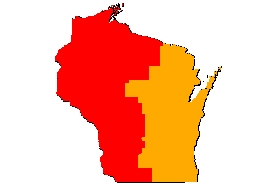Non-native Phragmites or Common reed
(Phragmites australis)
Perennial wetland grass that grows three to 20 feet tall with dull, very slightly ridged, stiff and hollow stems. Create dense clones where canes remain visible in winter.
Other names for this plant include:
- Common names: common reed grass, ditch reed, giant reed
- Scientific names: Arundo phragmites; A. australis; P. communis
Classification in Wisconsin Prohibited/Restricted (Restricted in Brown, Calumet, Columbia, Dane, Dodge, Door, Florence, Fond du Lac, Forest, Green Lake, Jefferson, Kenosha, Kewaunee, Langlade, Manitowoc, Marathon, Marinette, Marquette, Menominee, Milwaukee, Oconto, Outagamie, Ozaukee, Portage, Racine, Rock, Shawano, Sheboygan, Walworth, Washington, Waukesha, Waupaca, Waushara and Winnebago counties; Prohibited elsewhere)
- Ecological Threat
-
- Invades moist habitats including lakeshores, river banks and roadways. It is common in disturbed areas and can tolerate brackish waters, dry conditions and alkaline to acidic conditions.
- It can quickly become established with extensive rhizomes taking over underground. These rhizomes store energy so the plant can recover from cutting, burning or grazing.
- Common reed alters hydrology and wildlife habitat, increases fire potential and shades native species.
- It can spread through root fragmentation, long runners above ground and sometimes wind-blown seeds or cut stem fragments.
- Identification
-
Leaves: Smooth, linear leaves are 15-60 centimeters (6-24 inches) long, one to six centimeters (0.4-2.4 inches) wide, and blue-green in color; leaf sheaths tightly clasp the stem, are difficult to remove and stay on throughout winter; black line and long, white hairs (ligule) are present at the junction of leaf and sheath.
Flowers: Bushy, light brown to purple plumes are composed of spikelets that bloom July-September; plumes are 19-38 centimeters (7.5-15 inches) long and resemble feather dusters.
Fruits & seeds: Small and tan with many white hairs attached.
Roots: Stout oval rhizomes can reach up to 1.8 meters (six feet) deep and three meters (10 feet) horizontally.
Similar species: Native Phragmites (Phragmites australis ssp. americanus) has smooth, flexible stems, often with shiny, round, black spots (a fungus). Its inflorescence is usually sparser than non-native Phragmites, as are most patches where it grows. Several species of ornamental grasses (Miscanthus spp.) can be confused with Phragmites due to their showy, feathery plumes. However, they have smaller diameter stems, narrower and longer leaves, sometimes with a white mid-rib and white inflorescences.
- Distribution
-
See the reported locations of non-native phragmites in Wisconsin.
Do you know of additional populations? Send us a report.
- Control
-
Mechanical: After a chemical application either mowing or burning can be used for additional control and maintenance.
Chemical: Imazapyr or glyphosate can be used as a foliar spray or applied to cut stems after using the bundle and cut method in late summer-fall. The use of herbicides near water or wet ground may require a permit and aquatic formulas of herbicide.
- Resources
- Sources for content:
- Michigan Department of Environmental Quality's Guide to the Control and Management of Invasive Phragmites (3rd ed., 2014) [exit DNR]
- USDA National Invasive Species Information Center: Common Reed [exit DNR]
- Invasive Plant Atlas of New England: Common Reed [exit DNR]
- Plant Conservation Alliance Factsheet: Common Reed [exit DNR]. Last updated in July 2009.
- Protect your Wetlands from Invasive Phragmites [PDF] (or printable PDF) posted in October 2016.


